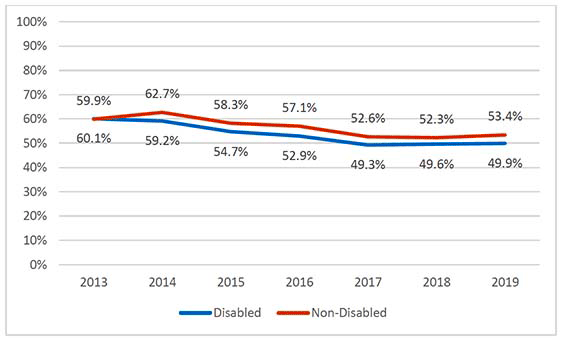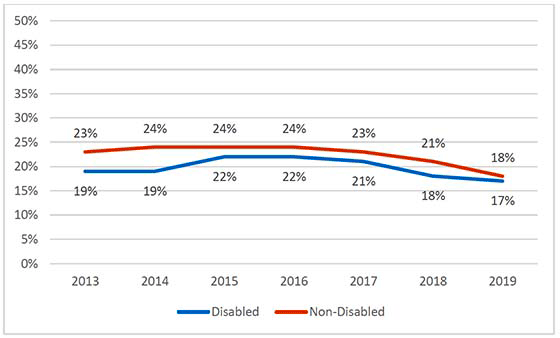National Performance Framework - disability perspective: analysis
Analysis which compares the outcomes and experiences of disabled people to those of non-disabled people using indicators drawn from Scotland’s National Performance Framework (NPF).
9. Human Rights
National Outcome: We respect, protect and fulfil human rights and live free from discrimination
The National Performance Framework has four indicators for human rights, one of which does not have an indicator at present, and three of which have updated data available:
Quality of Public Services (Pre COVID-19 Data)
The SHS asks respondents if they are satisfied with their local services. Figure 19, below, demonstrates in the period 2013-2019 disabled people were slightly less likely than non-disabled people to be very or fairly satisfied with their local services.[55] This gap in satisfaction was at its widest in 2016, when significantly fewer disabled people were satisfied with their local services than non-disabled people (52.9% of disabled people vs 57.1% of non-disabled people). In 2019 this difference in satisfaction was also significant, when 49.9% of disabled people felt satisfied with their local services, compared to 53.4% of non-disabled people.

Source: Scottish Household Survey 2013-19
Influence over Local Decisions (Pre COVID-19 Data)
Figure 20, below, demonstrates in the period 2013 to 2019 disabled people were slightly less likely than non-disabled people to agree with the statement 'I can influence decisions affecting my local area'. The gap in opinion, however, has narrowed over time. In 2013 just under one fifth (19%) of disabled people agreed with the statement, compared to just under one quarter (23%) of non-disabled people. By 2019, there was a difference of one percentage point between disabled (17%), and non-disabled people (18%), this difference is not statistically significant.[56]
In 2017, 21% of disabled people agreed with the statement "I can influence decisions affecting my local area", but by 2019 this had reduced significantly to 17%.[57]

Source: Scottish Household Survey 2013-19
Access to Justice (Pre COVID-19 Data)
The SCJS demonstrates that in 2018/19 slightly fewer disabled adults were confident that everyone has access to justice system when they needed it than non-disabled adults. In 2018/19 just under three quarters (73%) of disabled people were confident that everyone had access to the justice system when they needed it, compared to just over three quarters (77%) of non-disabled people. Almost a fifth (19%) of disabled people were not confident that everyone had access to the justice system when they needed it, compared to 15% of non-disabled people.[58]
The SCJS found that the proportion of disabled adults who were confident that everyone has access to the justice system when they need it had increased significantly from 68% in 2017/18 to 73% in 2018/19. The proportion of non-disabled adults who were confident that everyone has access to the justice system when they need it showed no change over the same time period.
Inclusion Scotland ran a short survey (n=164) from Tuesday 10 November 2020 until Tuesday 17 November (during the COVID-19 pandemic) to ask disabled people their views on the A Fairer Scotland for Disabled People plan. Disabled people were asked if they thought the accessibility and fairness of the justice system had got better, got worse or stayed the same since 2016. 40% of respondents said they were not sure, 29% said it had stayed the same, 24% said it had got worse and 7% said it had got better.[59] It's worth noting that the ongoing COVID-19 pandemic was likely to have negatively impacted responses to this survey.
Additional Indicators
Support Services (COVID-19 Data)
Inclusion Scotland asked disabled people if they thought support services for disabled people had got better, got worse or stayed the same since 2016. Half (49%) said support services had got worse, around a third (34%) said they had stayed the same, 9% said they had got better and 8% said they were not sure.[60] It's worth noting that the ongoing COVID-19 pandemic was likely to have negatively impacted responses to this survey.
Active Participation (COVID-19 Data)
Inclusion Scotland asked disabled people if they thought the participation of disabled people in daily and public life had got better, got worse or stayed the same since 2016. Most people said participation of disabled people in daily and public life had either stayed the same (36%) or got worse (31%), 19% said it had got better and 14% said they were not sure.[61]
Contact
There is a problem
Thanks for your feedback